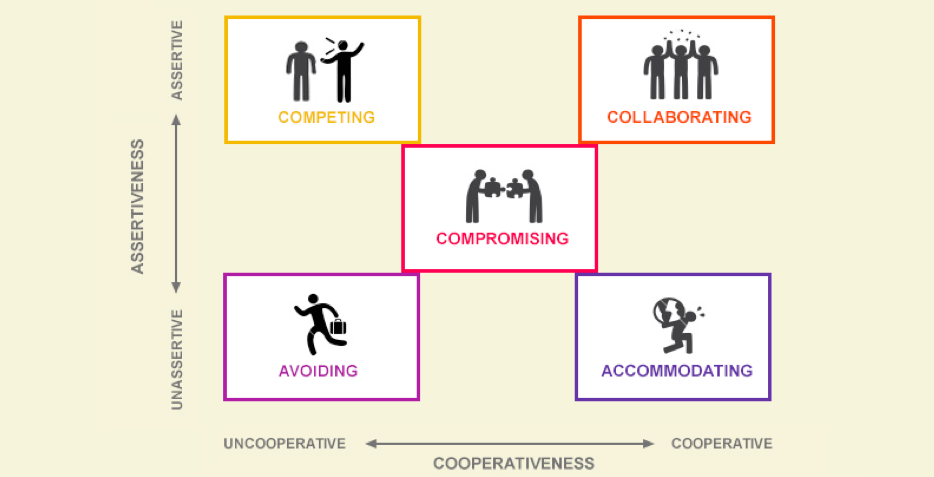Firing people is perhaps the most difficult things a leader must do for the team and organization. Unfortunately, I’ve been in the position of needing to do so more than I’d like (once is too often.) One person I had to “let go” partly because he wouldn’t be honest with me whenever I confronted him. He worked very hard at avoiding any form of conflict. Even on the day I notified him I would have to fire him, he smiled at me and told me it was OK, even though I knew he liked his job and wanted to keep it.
For leaders, confrontation is inevitable. It can be very difficult to lead people who consistently exhibit a particular styles of conflict, especially if it is different from our own. Knowing how others handle conflict, as well as how WE handle conflict, will empower us to more effectively lead them and our teams. Bringing this form of self-awareness to ourselves and our team will also create new language and understanding that will, over time, enable all involved to succeed in team communications.
Enter the Thomas-Kilmann Instrument. An assessment that measures conflict styles based on both assertiveness and cooperativeness. Although the assessment is a useful tool, simply understanding the various positions people tend to lean towards is often enough to engage meaningful conversations within your team.
The Five Styles of Conflict

Following is a brief description of each style, as explained by the author’s of the assessment.
- COMPETING is assertive and uncooperative—an individual pursues his own concerns at the other person’s expense. This is a power-oriented mode in which you use whatever power seems appropriate to win your own position—your ability to argue, your rank, or economic sanctions. Competing means “standing up for your rights,” defending a position which you believe is correct, or simply trying to win.
- ACCOMMODATING is unassertive and cooperative—the complete opposite of competing. When accommodating, the individual neglects his own concerns to satisfy the concerns of the other person; there is an element of self-sacrifice in this mode. Accommodating might take the form of selfless generosity or charity, obeying another person’s order when you would prefer not to, or yielding to another’s point of view.
- AVOIDING is unassertive and uncooperative—the person neither pursues his own concerns nor those of the other individual. Thus he does not deal with the conflict. Avoiding might take the form of diplomatically sidestepping an issue, postponing an issue until a better time, or simply withdrawing from a threatening situation.
- COLLABORATING is both assertive and cooperative—the complete opposite of avoiding. Collaborating involves an attempt to work with others to find some solution that fully satisfies their concerns. It means digging into an issue to pinpoint the underlying needs and wants of the two individuals. Collaborating between two persons might take the form of exploring a disagreement to learn from each other’s insights or trying to find a creative solution to an interpersonal problem.
- COMPROMISING is moderate in both assertiveness and cooperativeness. The objective is to find some expedient, mutually acceptable solution that partially satisfies both parties. It falls intermediate between competing and accommodating. Compromising gives up more than competing but less than accommodating. Likewise, it addresses an issue more directly than avoiding, but does not explore it in as much depth as collaborating. In some situations, compromising might mean splitting the difference between the two positions, exchanging concessions, or seeking a quick middle-ground solution.
Further Thoughts
- A great leader will understand when to use each of these conflict styles. Life is too messy to just pick one and stick with it. We must give ourselves permission to jump from style to style based on the circumstances. The key is to ensure that the team and organization’s goals are at the forefront of these choices each time.
- It’s important as leaders that we understand which style we lean towards, and how that tendency affects others. For example, competitive leaders may tend to bulldoze over others and fail to take the time to understand other options. Avoiding leaders may inadvertently build an untrustworthy culture if they aren’t willing to address elephants in the room at times. Accommodating leaders may allow others to push their agenda more than is healthy. Even Collaborative leaders must remember that there are times when a decision must be made without taking the time to address and include everyone’s input.
- There is a difference between a Servant-Leader and an Accommodating Leader. Although it’s important for servant leaders to be willing to give up their own rights to advance and strengthen the team, it shouldn’t be at the expense of their own core values or the bigger needs of the organization.
- Informed leaders will seek to understand where other team members lean in conflict scenarios. This will allow them to better lead them and, when necessary, coach others towards a more balanced approach before and during confrontations.
- In team environments, it’s almost always best to work towards a collaborative approach as much as possible. This allows everyone on the team to have a voice and maximized buy-in for all involved.
- Discussing conflict styles would be a GREAT CONVERSATION to have in team meetings. It will help build a language that can be used in future meetings and between team members. It will also encourage both self-awareness and social-awareness among your team members.





